

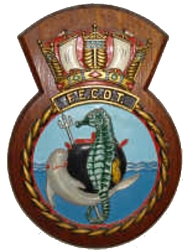
By the time the Clearance Diving Branch had been formally established in 1952, clearance divers had burst upon the unsuspecting major fleets of the Royal Navy. The Far East Fleet Clearance Diving team (FECDT) travelled by troop ship to Hong Kong in 1951, stopping at a number of the many naval bases along the way in those days including Gibraltar, Malta, Aden, Tricomalee and Singapore. Led by Lt Eric Gash RN and CPO Nick Carter, their immediate task was to train shallow water divers and then exercise the ships of the Fleet in their defence against attack by underwater swimmers. But it was not long before the team embarked on a tour of the station to undertake the disposal of various types of explosive ordnance left over from WWII, above and below the water. This was a task that would dominate the team’s activities for the whole of its twenty years of service in the Far East.
South East Asia provided a happy hunting ground for all forms of ordnance. In 1953 the team disposed of some fifty tons of Japanese bombs lying under and around Ayer Samak jetty, Singapore. There were about 200 of them ranging from 50 to 250kg, mainly high explosive with some phosphorous and anti-personnel. Some were sunk in the mud with only their tails showing, many were fused together and all were covered in marine growth. So dangerous did they seem that it was decided to countermine the lot. The village was cleared during the morning and at 1230 there was a very large explosion that provided the whole community with a fish supper.
Personnel came and went; Harry Wardle took over from Eric Gash. The team continued their regular visits to Singapore and Malaya for the disposal of ordnance and general diving duties. It was during one of these visits that tragedy struck the team when LS(D) Charles Brian Larkin, aged 21, suffered a fatal shark attack on 28 July 1954 while diving in 20 feet of water off the commercial harbour in Singapore. He died shortly after being brought back into the diving boat and is buried in Kranji Military Cemetery. As recorded here on the Veterans UK website, his name is included on the Armed Forces Memorial and the Roll of Honour at the National Memorial Arboretum. After further visits to Penang and Port Swettenham, the team returned to Hong Kong to resume their training duties with the Fleet.
The team continued its training task in Hong Kong and its regular tours elsewhere in the region until 1957 when its commitment to the disposal of ordnance in Singapore and Malaya was taken over by a new team led by Peter Messervy and Ted Butler.
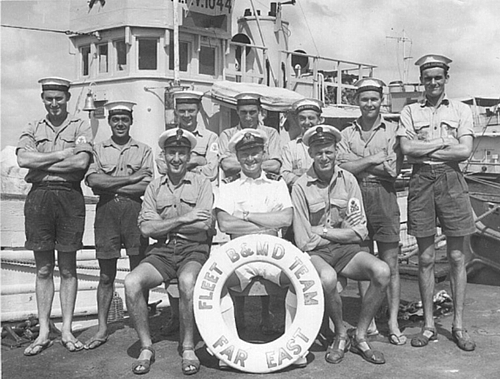
with Lt Peter Messervy MBE GM RN centre
The team’s most interesting job
was in June 1959 when they removed six live torpedoes from a sunken Japanese
submarine off Keppel Island in the Johore Strait for which Peter Messervy
was awarded the George Medal.
He
and the team worked for several weeks to extricate the torpedoes at a depth
of 42 feet, often in nil visibility, sometimes using flame-cutters only a
few feet away from the live warheads.
While
working on the submarine, the team received an emergency request from the
Army to recover a new and secret type of Belgian rifle, inadvertently
dropped in a river in the Johore jungle. It was vital that the weapon
did not fall into terrorists' hands and the team found it in a single dive.
The B&MD team also became involved in a high profile salvage operation after the Singapore Harbour Tug Pitho capsized and sank in the western entrance to Keppel Harbour following a collision with a Japanese freighter. This effectively blocked the harbour entry to be used by the Royal Yacht Britannia some ten days later. The team carried out a survey that revealed the tug was relatively undamaged and the Navy was asked to raise it. The team passed 7” wires under the tug and secured them to four flooded ‘camels’ secured between two bar vessels that assisted the hoist once the camels had been blown. Unfortunately, the 7” wires parted during the lift, the Pitho remained on the sea bed and the Royal Yacht was diverted. A few days later, the team returned to the task using heavier gear including 9” wire tailed with chain cable to secure two ‘camels’. The two bar vessels then succeeded in lifting Pitho which was then pumped out, refitted and returned to service.
In 1959 it was decided that the Hong Kong team should be
moved down to the Sembawang Naval Base in Singapore to join forces with the
B&MD team and set up the Fleet Diving Centre in HMS Terror. Facilities were
installed ashore for the team and the school was provided with the diving
tank brought down from Hong Kong and an old battle practice target to act
both as a diving platform for the trainee divers and a jetty for the various
craft the teams had acquired.
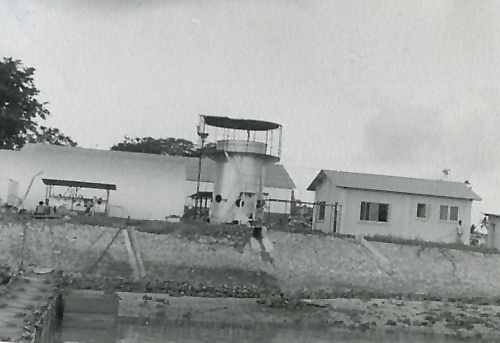
Before the FECDT finally departed
Hong Kong for its new base at HMS Terror in the Naval Base at Singapore,
FCDO Arthur Checksfield was dined out from HMS Tamar.
It
so happened that this coincided with the Governor of Hong Kong’s annual
attendance at a mess dinner.
Arthur
was well known for his sense of humour and the members looked forward to his
words of farewell.
So it was with some slight disappointment that
they heard his quiet words of thanks to the mess and politely applauded as
he sat down. They
did not see him light the blue touch paper that initiated the Chinese
firecrackers secured under the table along its length that were so vigorous
in their action that the table took off.
The
Governor was not amused and expressed the desire that Arthur, having left
Hong Kong, should not return while the Governor was still in office.
Perhaps
this was why, during the (essential) Hong Kong part of his turnover to Mike
Gillam a few months later, it took place largely downtown, outside the naval
base.
With both teams working as one in Singapore, they continued with fulfilling their main tasks of training and B&MD. In 1961, the team joined the Inshore Flotilla on its clearance of those areas off North Borneo where the charts still indicated a danger from WWII mining operations. The team was based in HMS Woodbridge Haven (know affectionately as 'Woo-Ha'), its task to carry out a visual survey of those areas too close to the coral for conventional sweeping operations. This required long underwater swims from dawn to dusk from small open boats. Thus it became known to the team as ‘Operation SUNBURN’. After a week of unremitting toil, the flotilla repaired to nearby Sandakan for couple of days R&R and, as expected, some team members slid ashore for a couple of beers or so. This provided them with an opportunity for earnest debate on matters thought to be of importance.
As the evening progressed, the discussion of one particular couple became quietly physical. It was, perhaps, unfortunate that the Naval patrol, amateurs to a man, were passing by and mistook the friendly tussle for an old fashioned fracas. So the patrol walked the two chums back to the jetty for a formal resolution of their discussion. It was even more unfortunate that the First Lieutenant had decided that single brow was all that was needed. This provided an ideal platform from which the two chums made their stand. Standing back to back, they challenged the patrol to move them. This took place in the early evening, that busy time when the last of the guests to the official ‘first night in’ cocktail party were arriving and the first of the guests were just leaving. A message swiftly passed from the officer of the day to Captain IF, then to the Boss and finally to the Chief who dispensed his own unique form of physical debate and the problem was solved.
Operation SUNBURN continued but no mines were found.
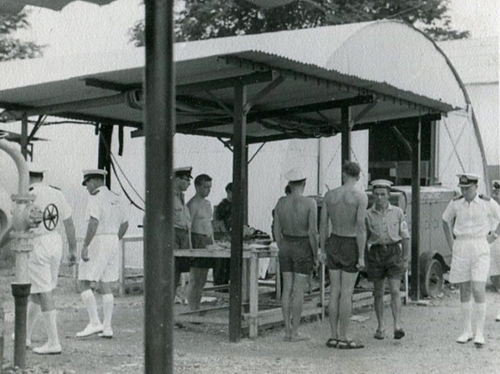
Captain's Rounds of the Fleet Diving Centre at
HMS Terror in Singapore
One day the Boss was summoned to the Fleet HQ by CSO (Ops), FTASO being away. An emergency had arisen. One of the CMS (Coastal Mine Sweepers) had managed to damage both her screws on a coral reef off North Borneo and was unable to return to Singapore under her own power. Could the team save the situation with a double screw change underwater on site?
The Boss was committed to a Fleet
exercise and Boss 2 was away on a bomb job so it was suggested that the PO
CD1 would undertake the task.
He would arrange with the RAF for a small team
to be transported, together with its equipment and the two CMS screws,
liaise with the local authorities, do the double screw change and return
back to base, safe and sound.
“Are you sure?” asked CSO (Ops)
“Absolutely,” said the Boss.
“On your head be it,” said the CSO. Being one of the old school, he added, “I have heard that you call your divers by their first names. What do they call you?
“Boss,” said the Boss.
The job went well as everyone who knew the team was sure it would. CSO (Ops) was Captain Leach (later Admiral of the Fleet Sir Henry Leach) and Tom King was the PO CD1.
Early on in its time in the Far East, the team was provided with a fleet of small craft led by the elderly MFV 1044 (75 feet) and MFV 164 (50 feet) with a small engineering team to keep them running. They provided transport, accommodation and a reasonable platform from which many diving and B&MD operations were carried out. The longest voyage that they were required to undertake was from the Singapore Naval Base up the East Coast to Pulau Tioman, the island where the fleet anchored during the local annual training exercise. These trips always included an opportunity to exercise the ships’ response to underwater attack by divers and check the ability of ships' diving teams to search underwater.
To while away the time when the fleet was away from the anchorage, the FECDT took the opportunity to explore the waters around the island and engage in some barter with the islanders - giant clams for coconuts. Despite the efforts of the engineering team, the elderly MFVs were not always reliable so one year it was decided that both should make the trip in case one or the other might have problems. In the event, all went well until the return journey when one MFV failed and the other took it in tow. Then as the pair made their way into the Johore Strait, the second one failed so both MFVs were towed home by a CMS from the Inshore Flotilla, returning to base. It took a long time to live that down!
This episode concentrated minds on the need for a obtaining a more reliable vessel from which future diving operations might be conducted and it was suggested that one of the junks confiscated by the authorities in Hong Kong might be adapted by the dockyard for the purpose at little cost. This was formally proposed to MOD (Navy) for urgent consideration. Some months later, the team was informed that the junk’s stability curves were required to ensure that proper service standards could be met. It turned out that these were only obtainable from the men who had constructed the vessel, by hand, from skills developed over a thousand years – if they could be found – so the plan was abandoned in favour of a much better idea; to design and build a diving support tender from scratch.
The diving tender Datchet was built in Singapore for the RN a few years later. She had a steel hull and a comparatively fragile marine plywood superstructure. It was said that she led an interesting and improbably charmed life in all manner of places.
She was a pig of a thing; so
noisy at sea that no one slept. There was a buzz that quieter engines
were to be fitted but it was just a buzz!! The RN could have
done much better than her for a lot less.
Datchet was shipped to the UK in 1974 for service as a Diving Tender attached to HMS Vernon and later, the Plymouth Clearance Diving Team. She was sold in 1994. [By Webmaster: More photos and information about Datchet in her later life are scattered around the website. Use the Freefind search facility on the Home page to find them.]
During the early sixties, the situation became difficult in Hong Kong owing to a noisy minority intent on making life difficult by planting explosive devices around the city. John Coggins, who was sent out to assist the army in dealing with the situation, recalls the occasion:
When I got to Hong Kong I had to report to some pompous
Major who always wanted me to march into his office and salute him.
I
told him the Navy did not do things that way. We never got on that well.
The first homemade bomb I came across was outside a
bank. The
day before, I was instructed by an Army EOD man who just kicked the homemade
bombs to check they were harmless.
I
decided not to do this so I lassoed it, went round the corner and pulled the
string. It
went off like a mini atom bomb!
I
learnt later any bomb outside a bank was genuine!
They
often left a notice saying, “This is for white pigs only.
My people keep clear.”
Many
of course were false
One day I was patrolling the streets near the Peak when
a window opened and a voice said, "What is going on down there?" The
sailor accompanying me then shot at him.
Fortunately, he missed him and we heard no more
but people were told to keep their windows shut!
On another occasion, a bomb was placed in a hole in the
wall. The
Policeman who was with me said it was not a problem so I blew it up.
On
the other side of the wall was a very large electrical transformer, now
riddled with shrapnel and leaking large amounts of fluid, down a steep
incline. As
I looked up at the skyscrapers around me, I could see all the lights slowly
going out. Fortunately
the MoD had immunity and I was never held to blame!
We only ever stayed for two weeks to avoid getting bomb happy. The Army did
longer and paid the price!
One day, a bomb was placed on a very tall electrical
pylon near the top of the Peak.
I
said they would need to get a helicopter because I was not going to climb
it! The
helicopter duly arrived and I did the business (with the current off!).
What I did not realise at the time was half of
Hong Kong was watching, including the Governor General and the Commodore.
The publicity did me no harm.
It was reported that the most
frightening aspect of the task was travelling in a police Land Rover during
the rush hour, siren blaring, at full speed, on the wrong side of the road,
through red lights.
Those were the days!
John returned to the Far East as Fleet B&MD Officer and was appointed an MBE for his efforts that included the clearance of Japanese torpedoes.
The largest clearance of ammunition took place in 1962 when the team was tasked to clear another WWII dump in the West Johore Strait. A mixed bag of British, American and Japanese ordnance was scattered over a large area. After an initial series of circular searches in depths from 30 to 80 feet, ammunition was brought to the surface by hand and placed underwater out of the sun in Carley rafts to keep it out of the tropical sun. From there it was transferred to an ammunition lighter and placed in canvas baths where it awaited weekly collection. This was a joint service operation with the Navy recovering the ammunition, the army dumping it in deep water out at sea and the RAF providing an excellent base for the operation from its yacht club nearby. For the first three months about a thousand rounds per month were recovered using the Carley raft method but then the search moved into a more densely packed area where the ammunition was piled up in heaps and a more efficient means of lifting was required. Anchoring the MFV over the ammunition made the lifting easier but it still required a hoisting team. So dense became the piles of abandoned ammunition that the army provided a 'Z' lighter and a crane which increased the recovery rate to some thousand rounds per day.
The job took seven months and 650 diving hours to complete. The ammunition examiners recorded 29,447 individual items of ammunition weighing some 400 tons, about 80 tons of which were lifted by hand. The ammunition itself was a mixed bag of British, Japanese and American ordnance in varying states of disintegration. The largest single items were Japanese 250 kg bombs which invariably spilled their cast picric filling all over the deck. In best condition were British 250 lb bombs and most numerous were British 25 lb HE shells. The most interesting items were the British 81mm mortar rounds, usually fused together in clumps of three or four, partially rotted with strikers exposed. The ammunition examiners declared them unarmed and safe because they hadn’t been fired. They were still handled very gently! Those items considered too dangerous were taken to a deserted beach in the vicinity and countermined.
There were few hairy moments; it was mostly just hard graft. However, the Boss was called out over Easter as smoke was seen rising from one of the canvas baths in which the ammunition was stored underwater waiting disposal; some of the water had drained away leaving the rounds exposed. The situation was resolved by the swift addition of water. On another occasion, the Boss jumped a mile when the expansion of gas in a recovered 75mm shell case caused the shell to skitter across the deck right past him. That made everyone laugh.
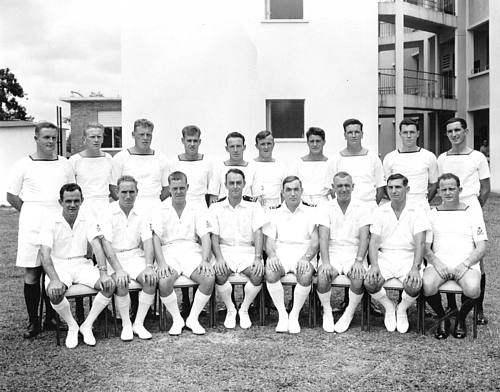
Far East Fleet Clearance Diving
Team 1962
Back row: Peter 'Brum' Fowles, Doc Campion, Brian Martin, Simon
Russell, Tansy Lee,
Dolly Dolan, Harvey Sumner, Vic Humphrey, Gilbert Bartholmew and Tom Fisher
(ME)
Front Row: Mick Roberts, Mike McCall (POME), Bob Atkinson,
James Majendie,
Mike Gillam, Brian Fawcett, Tom King and Stan Templeton
The team’s services also extended to the salvage of ships and the demolition of underwater hazards. One of the more unusual jobs involved the recovery of over 100 tons of oil well equipment in 1963, seven miles off shore from Seria in Brunei. The equipment had been lost from a floating oil drilling rig during a gale. Six members of the team spent a month working around the clock to recover drilling equipment that included 7,000 feet of oil drilling pipe. PE had to be used to clear damaged sections of the 28” piping. Divers were restricted to 40 minutes underwater once a day due to the depth at which they were working.
Throughout the sixties, the FECDT
continued training divers; exercising the Fleet; performing underwater screw
changes and other ship husbandry tasks; searching for items lost at sea;
conducting salvage operations; and undertaking the never ending task of
explosive ordnance disposal in the waters of South East Asia as far west as
the Andaman and Nicobar Islands. The team even practiced arriving on task by
parachute. The
team also worked with similar groups from the Malaysian, United States and
Australian navies.
Above and below: Far East Fleet CDT at HMS Terror, Singapore in 1962
including Lt James Majendie RN
During 1965, FCDO David Burstall and the
team had the privilege of carrying out a brief diving survey on HMS
Repulse.
Approval
for this operation was granted on the grounds that it would be good training
value as well as being of unusual interest.
Although
Repulse
is not officially designated as a War Grave, it is regarded as such and
stress was placed on the requirement that the ship was not to be entered and
nothing was to be disturbed externally.
This
trust was faithfully observed.
HM Ships
Repulse
and
Prince of' Wales were sunk within
an hour of each other by Japanese high level and torpedo bombers on 10
December 1941. The
Repulse was the first to sink at
1233 as a result of five torpedo and one bomb hits.
The
Prince of Wales
followed at 1320 having sustained five or six torpedo hits (two port side
aft, followed by three or four forward, midships and starboard side aft) and
one bomb hit. Both
ships heeled over and capsized to port on sinking, with the
Repulse
proceeding at approximately 15 knots and the
Prince of Wales
reduced to less than 8 knots.
The
ships came to rest with the
Repulse lying in a depth of 180
feet and the Prince of Wales eight miles to the east in a depth of 216 feet.
HMS
Repulse
lies some 45 miles NNE of Pulau Tioman off the east coast of West Malaysia.
HMAS
Yarra
laid a datum dan buoy some three days before diving operations were
scheduled to begin and HMS
Barfoil, acting as Diving Support
Ship, with MFV 164 (Diving Team embarked) in attendance, laid an accurate
heavy marker alongside
Repulse.
Diving
conditions, generally, were excellent.
The
water was very clear and underwater visibility was so good that the silvery
shape of
Repulse could be seen from the surface of the sea
through a face-mask, before the sun rose too high and veiled her with the
increased reflection from the mass of particles in the water.
Those that claim to have seen
Repulse
from the air and to have clearly seen her mast are mistaken.
In fact, they have seen the shadow area cast by
the bulge keel for this majestic and awe-inspiring ship lies on the sea-bed
almost completely capsized to port with her starboard bilge keel uppermost
and her decks under-hanging the horizontal by about 30 degrees. She lies in
a mean depth of 180 feet with the stern in slightly deeper water of 196
feet, perhaps caused by a tidal scour created over the years by prevailing
ocean currents. The
bows lie on a heading of 196 degrees (true).
The hull was in very good condition with remarkably
little marine growth other than a scattering of sea eggs, a few anemones and
small clams about eight inches across.
On
the wooden decks, which are bleached white and have lost their caulking,
hang a mass of oysters.
Fish
life abounds and the first customers normally seen on the way down were
large shoals of barracuda, static and staring with those big beady eyes.
Highly
coloured angel fish and parrot fish were always present around the wreck
and, occasionally, larger and more fearsome inhabitants in the form of big
groupers over six feet long which were given a wide berth by the divers.
The only sign of action damage was a large jagged hole
some 20 feel aft of and slightly above the starboard bilge keel from which
twisted pipes and machinery protruded.
The
theory put forward that the 15 inch turrets fell out when the ship capsized
is certainly not so in the case of `Y' turret, which was seen to be properly
in place and trained aft.
Had Repulse been upright and her mast intact, it was
the team’s intention to replace her battle ensign prior to leaving the area.
As
this was not possible, a mast was made up of a 60 foot span of dan wire
supported by three elliptical floats.
This was `keel hauled' into position and secured
to its own part around a propeller shaft.
From
this ‘mast' and immediately below was sewn a six breadths White Ensign which
was last seen proudly billowing out in the tide.
In 1966, FCDO David Lermitte and the
team returned to the area and carried out a similar survey of HMS
Prince of Wales,
having first fixed her position by sonar.
The
team was backed up by Clearance Divers from HMS
Sheraton
and the Royal Australian Navy's CDT 1 with HMS
Barfoil
once again acting in support.
A total of 64 dives were carried out between 160
and 180 feet involving an overall underwater time of 33 hours. The weather
was fine but the ocean current, although not strong, was unpredictable and
at times hindered the operation by making the positioning of the diving
support ship above the wreck difficult.
The
Prince of Wales
was lying on a heading of 020° completely capsized.
The
shallowest part of the ship is in the vicinity of her starboard bilge keel
at a depth of 150 feet.
It
was only possible, in the limited time available, to dive on three separate
zones, amidships in the vicinity of the engine room, right forward on the
stem and the right aft in the vicinity of the propellers and rudders.
There was a large jagged hole about 20 feet in diameter
in the forepeak, passing right through the ship, and in one place fracturing
the stem post. The
starboard outer shaft crossed over the starboard inner and its propeller was
wedged between the inner shaft and the hull.
There
was a jagged hole some six feet in diameter slightly forward of where the
two shafts cross over.
The
port outer propeller was missing and the bare shaft had been pulled away
from the ship snapping the A-bracket in the process.
There
was a large hole about 12 feet in
diameter a few feet forward of the A-bracket stub with the shipside plating
jaggedly bent inwards.
Diving conditions were generally good with, at best, a maximum horizontal visibility of 40 feet on the wreck, reduced to some 15 feet when the ocean currents stirred up the silt. The wreck abounded with marine life. Apart from one very large and lethargic whale shark, no other kinds of shark were seen but large shoals of barracuda were frequently in attendance and, on a few occasions, a large grouper.
Ex-CD1 Leo Whelan has kindly provided these photos of the Far East CD Team in 1963-5. It includes pictures of the first diving inspection of the wreck of HMS Repulse in 1965 and the placing of a white ensign on it (see full story here).
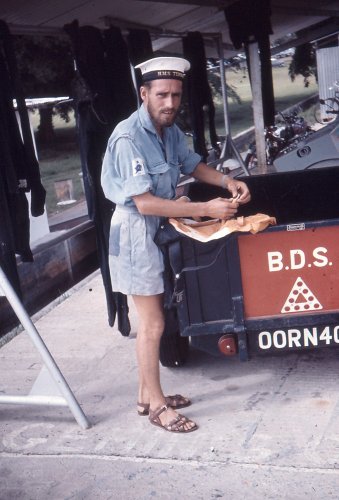
Leo Whelan
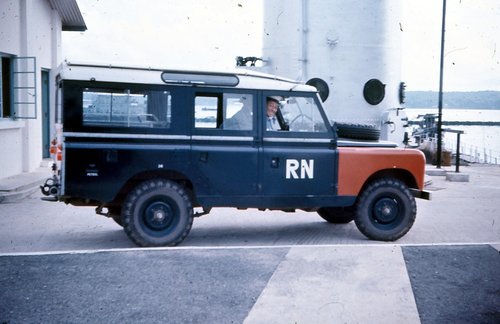
Jonno the 'Harley Bike Man'
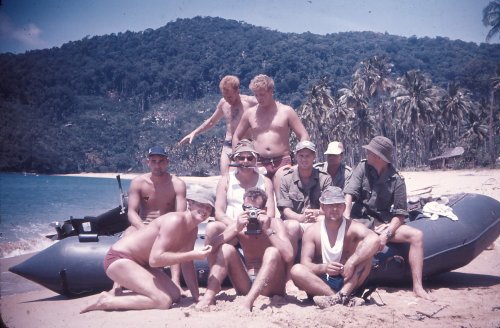
On the beach at Pulau Tioman
Back: Ginge Turton, Pincher Martin (Brum), Trevor
Gibson
Middle: Dave Coote, Bungy Edwards (Boy Seaman on
board HMS Repulse), Ginge Bishard, Lt Cdr David Burstall
Front: Jock Allardyce, Stafford Cripps, Jesse James
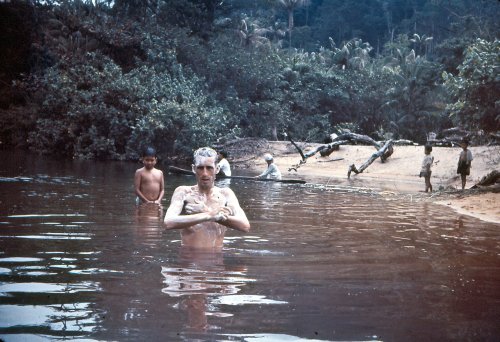
Leo Whelan has a bath at Pulau Tioman
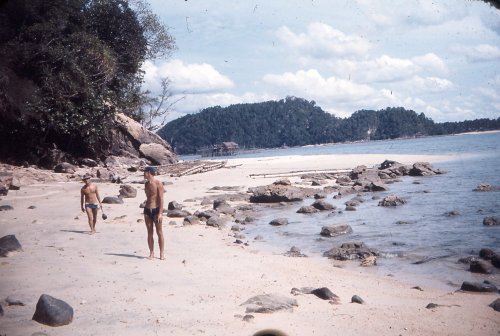
Harry Harris and Scobie Williams
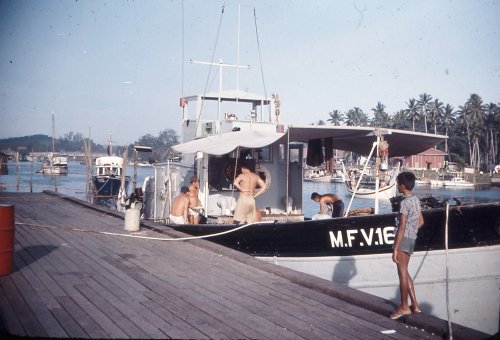
MFV 164 alongside at Mersing in Malaya.
Scobie Williams (wearing hat) and his team of locals
cleaning ship
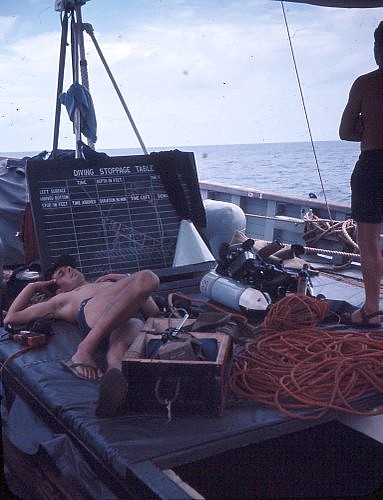
Scobie Williams above and Leo Whelan below
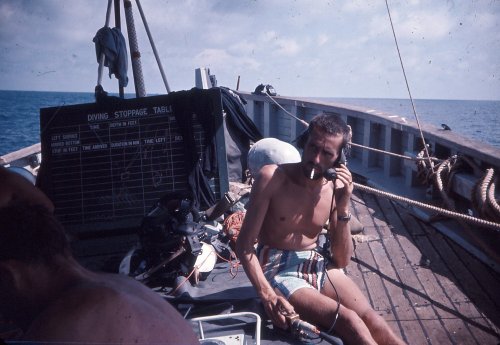
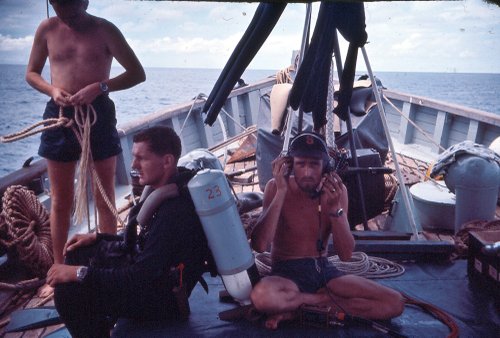
Lt Cdr David Lermitte, Peter Gallant (wearing
old-style SABA) and Leo Whelan
on board MFV 164
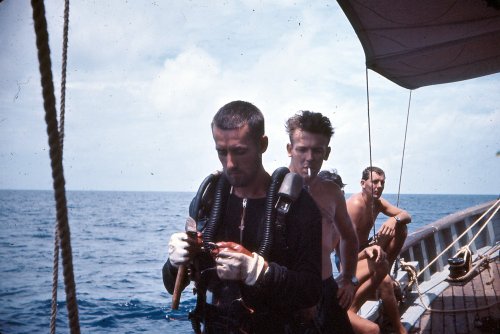
Leo Whelan, Jasper Peters and Pete Gallant
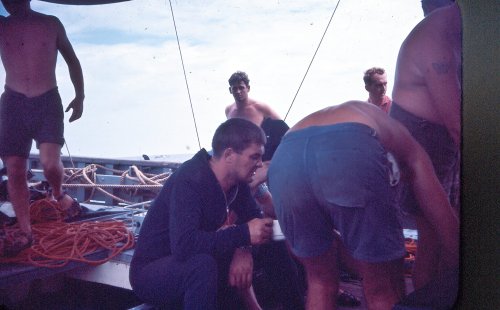
Back: RAN CD Billy Burrows and David Lermitte. Front:
Jesse James
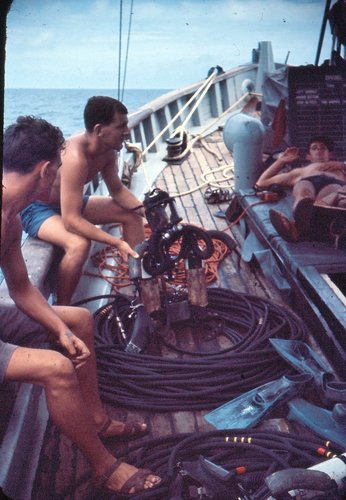
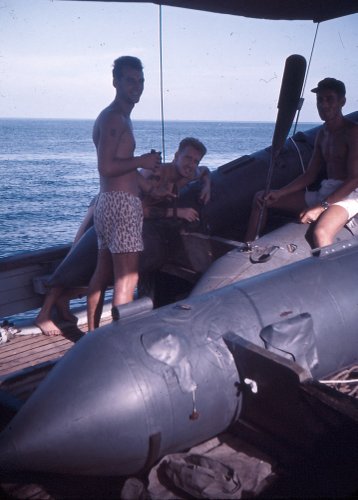
Left: Harry Harris and Scobie Williams (having a kip)
Right: Stafford Cripps, Ginge Turton and Leo Whelan
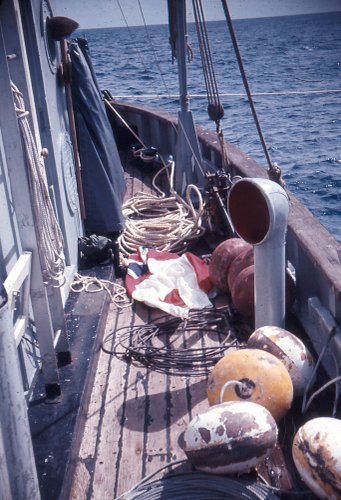
White ensign ready to be secured to the wreck of HMS Repulse
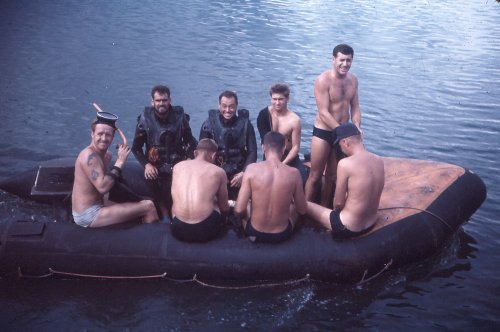
Back: Jock Elder, Jonno, Scobie Williams, RAN CD
Front: Ginge Turton, Dave Coote, 2 x RAN CDs,
CPO(CD1) Alan Jones RAN
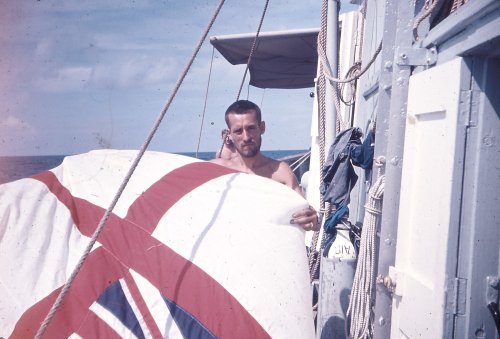
Leo Whelan with white ensign ready to be secured to
wreck of HMS Repulse
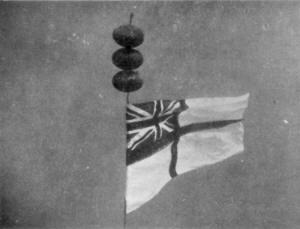
(Ensign after being placed on wreck of HMS Repulse)
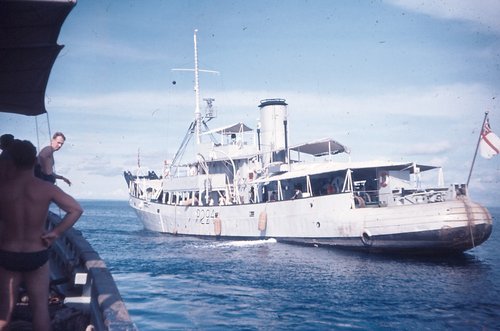
David Lermitte and Billy Burrows RAN with HMS Barfoil
in background
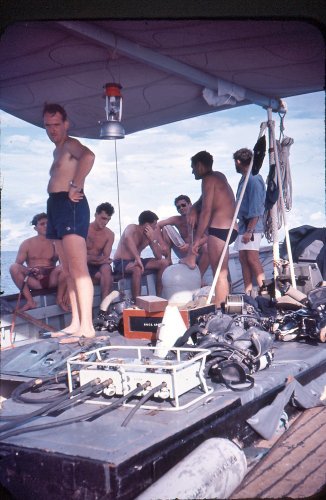
Front: David Lermitte
Back: Piggy from HMS Ajax, ?, Fred the PO Stoker
plus three RAN CDs and 'Skid' Marks in blue
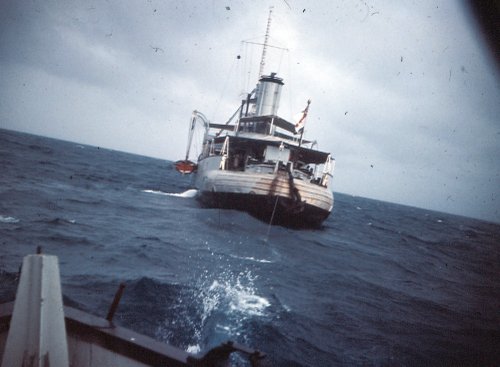
HMS Barfoil
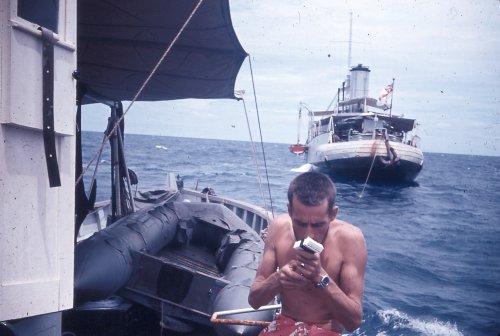
Leo Whelan on board MFV 164 with HMS Barfoil in
background
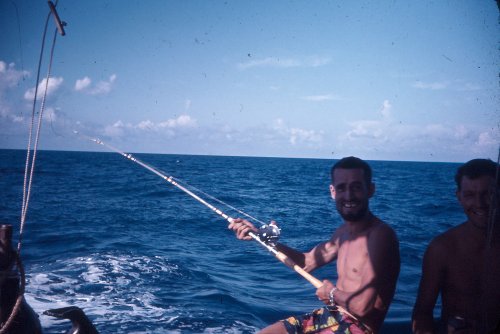
Leo Whelan does a spot of fishing
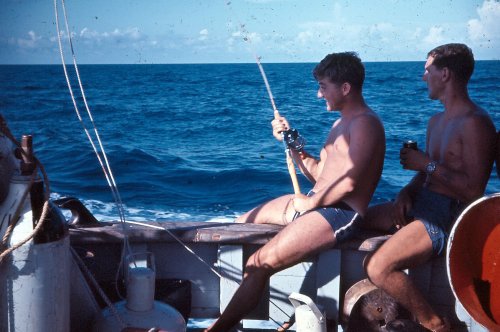
Peter and Piggy
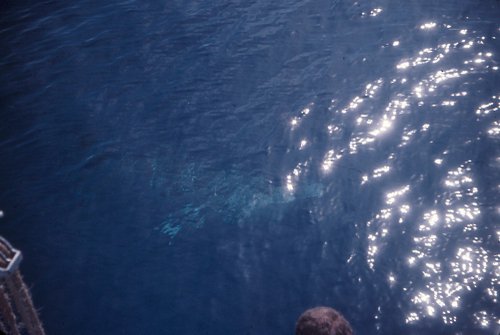
Above and below: Whale Shark
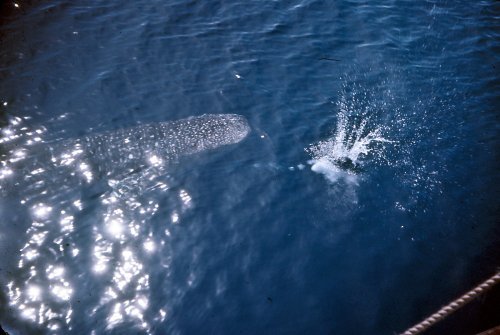
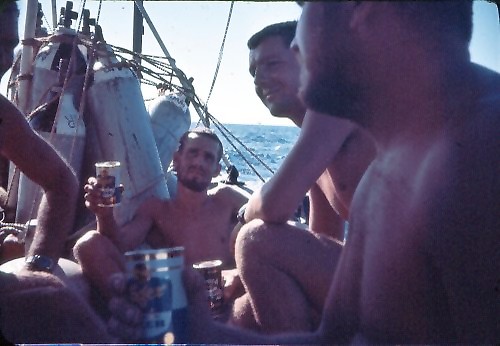
Leo Whelan, Pete Gallant and Vic Humphrey
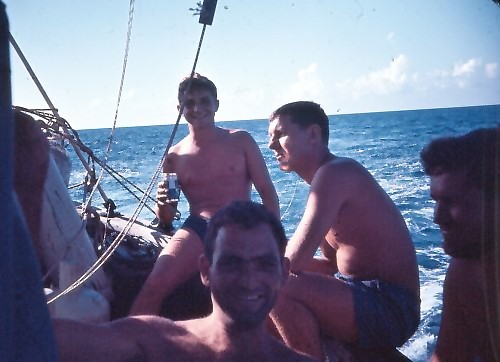
Piggy from HMS Ajax, Pete Gallant and Vic Humphrey
with RAN CD in middle
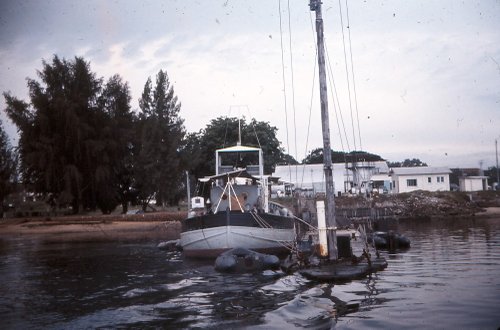
MFV 164 back alongside at HMS Terror in Singapore
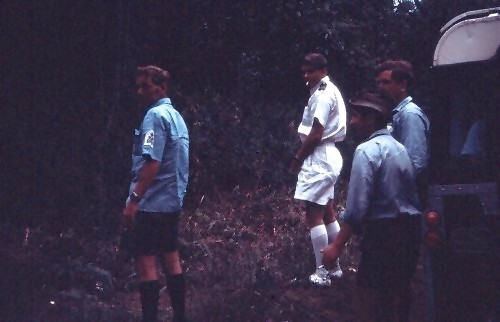
Shortie Ayres, MCDOA member Tim Trounson, Scobie
Williams and Vic Humphrey
on Kota Tingy Rd on way home
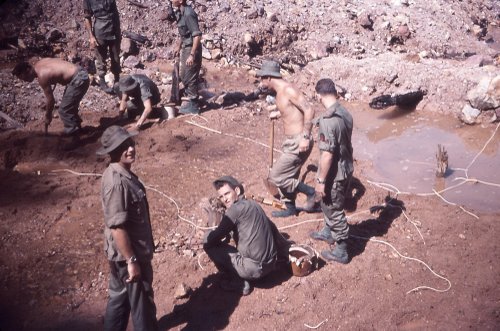
CPO(CD1) Alan Jones RAN, Pete Gallant and Jesse James
in Kluang, Malaya
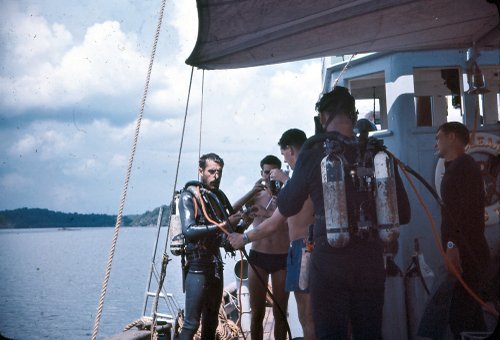
Leo Whelan, RAN CD, Pete Gallant, Jesse James and another RAN CD
Another unusual task in which the team
was involved concerned
RFA Ennerdale, which sank on 1st
June 1970 in 100 feet of water off the Seychelles while carrying 42,000 tons
of fuel oils. To
prevent the oil coming ashore, it was decided that immediate action should
be taken to release the oil so that the South East Monsoon would carry the
oil clear of the main islands.
Conventional methods of placing explosives alongside the hull, using boats and divers, were impractical in the heavy swell so a method was devised whereby three mortar bombs placed on a pallet would be lowered into position on the wreck from a helicopter, the cordtex fuse then being ignited by the crew inside the helicopter. With Ennerdale lying on her starboard side, and using a Wessex helicopter, this method successfully breached the port tanks, releasing about 12,000 tons of oil.
To reach the starboard side tanks
another demolition charge was constructed. To place the charge in the
correct position divers secured a 45 foot wire pennant to the top of the
wreck and, using a gemini dinghy, joined it to a similar wire lowered from
the helicopter. The dinghy raced clear, the helicopter crew lit the
cordtex fuse and released the bomb tray which, on its ninety foot pennant,
sank down alongside the vents on the lower tanks.
Later in the operation, after the
submarine HMS
Cachalot was unable to fire torpedoes into the
wreckage to free oil trapped in the hull, the warheads were taken off and
sunk alongside the hull.
When some of the warheads failed to explode,
FCDO Brian Braidwood dived to investigate the reason. He added some
short pre-cut delay fuses and ignited them while suspended above the wreck
from the helicopter on the winch wire. There was always a swell, often
heavy, and diving was dangerous. For showing remarkable ingenuity and
courage in a difficult and dangerous situation, Lt Cdr Braidwood was awarded
a Queen’s Commendation for Brave Conduct.
Following the government's directive in 1971 to withdraw forces from east of
Suez, the Far East Fleet Clearance Diving Team was replaced by a small group
of local divers to form the Singapore Armed Forces Diving Centre and look
after the naval assets then belonging to the Maritime Command.
During their time in the Far East, the Fleet Clearance Diving and B&MD teams
carried our many difficult, dangerous, unpleasant and sometimes boring
operations in addition to those mentioned.
These included searching for bodies as well as
the many items, large and small that had been lost overboard.
Over the twenty years of the team’s
existence, upwards of a hundred clearance divers served in it.
All conducted themselves in the best traditions
of the CD branch with great professionalism and mostly to their own
satisfaction. They
stuck to the strict principle of never turning down a job even though it
meant carrying out yet another fruitless search -
just under that wave!
They
operated in many different countries, from Kenya in the West to Fifi in the
East; from Korea in the North to Australia in the South; in India, Iran, the
Maldives, Mauritius and the Seychelles.
The following includes just some of the team bosses and members listed according to their duties, without rank or rating (promotions often occurred in post), with the first names by which they were known, an initial or surname only. Team members are listed in alphabetical order. Hopefully, the list will be corrected and added to by those who were there.
Fleet Clearance Diving Officers
Eric Gash
Harry Wardle
Arthur Checksfield
Mike Gillam
David Burstall
David Lermitte
Graham Shaw
Brian Braidwood
Jack Birkett
Tony Lumbard
Fleet Bomb & Mine Disposal Officers
Peter
Messervy
James Majendie
John Coggins
Tim Trounson
Dennis Selwood
Bill Norton
Fleet Team CD1s
Nick Carter
Ted Butler
Taff Roberts
Ron McKinley
Pat Christmas
Knocker White
Tom King
Bob Atkinson
Brian Fawcett
Ernie Foggin
Hoppy Hopewell
Tom Norman
Mick Fellows
Diving Instructor Diver I
Ted Soper
John Peach
Alderton
Ayres, Shortie
Bishard, Ginge
Carr, Nutty
Chaplin
Drain
Edwards, Bungy
Elder, Jock
Gallant, Pete
Gibson, Trevor
Harris, Harry
James, Jesse
Kempson
Le Cornu, ?
Marks, Skid
Peters, Jasper
Turton, Ginge
Whelan, Leo
Wiggans, ?
Williams, Scobie
Also see The Far East Clearance Diving Team in which MCDOA member Brian Braidwood provides an illustrated account of his time in command of the Far East Fleet Clearance Diving Team during the late 1960s.